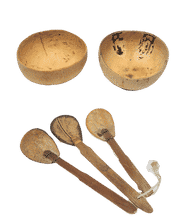Presented by Museum of the Peace Corps Experience and American University Museum
Coconut bowls (top)
c. 1961–63
Negros Oriental, Philippines
Coconut shell
2 x 5 1/2 x 5 1/2 in. each
Collection, Museum of the Peace Corps Experience
Gift of Elinor Dobbins Capehart
Philippines, Zamboanguita, 1961–62
Coconut spoons (bottom)
c. 1961–63
Negros Oriental, Philippines
Coconut shell, bamboo, twine
Dimensions variable
Collection, Museum of the Peace Corps Experience
Gift of Elinor Dobbins Capehart
Philippines, Zamboanguita, 1961-63

Before the road between Dumaguete City, capital of Negros Orientale, and our village of Zamboanguita was paved, before electricity, water, and sewers were available, we pumped water by hand to a storage tank on the balcony of the second floor of our four-room house.
We were four women PCVs living together with the woman who owned the house. She also cooked, cleaned, and did the laundry. This was a village of fishermen, subsistence farmers, and small harvesters of coconuts. The first group of volunteers in the Philippines were all “teacher’s aides” because the Peace Corps wanted to get a large number of volunteers into the country.
My rural primary school students made coconut bowls and spoons from a coconut shell and bamboo for the handle. My roommates and I hoped our students might be able to sell the coconut bowls if we helped them. They lacquered several of the bowls to show the rich colors of the coconut shells.
In the Mountain Province on the island of Luzon, artisans produced carvings of birds, animals, fruits, and weavings. I bought a wooden doll from a carver whose house was open to visitors. I asked whether he had anything he might have made for himself. He thought a moment, stepped out of the shop, and came back with a doll wearing a brass fertility symbol and carrying a baby. The symbol was in the shape of a uterus and fallopian tubes.
I then committed a cultural faux pas by admiring the earrings of the elderly woman in the household. The earrings bore the same fertility symbol and were made from old Spanish coins. She started to struggle to remove one of the earrings. I tried to say, “No, please don’t take them out”— but we did not speak a common language. I later learned that in this locale, when someone admires something you have, it is a cultural obligation for you to give that object to the admirer.
She told me through a family interpreter that she was glad to pass them on. She’d worn them since she was a girl, but her daughter had shown no interest in these old things. When I returned to the US, I had the earrings made into pins—one for my mother and the other for me. After my mother died, the pair of fertility earrings was reunited.
The Committee for a Museum of the Peace Corps Experience is a 501(c)(3) private nonprofit organization. Tax ID: EIN # 93-1289853
The Museum is not affiliated with the U.S. Peace Corps and not acting on behalf of the U.S. Peace Corps.
Museum of the Peace Corps Experience © 2024. All Rights Reserved.